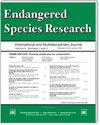Intra-species variability in migratory movement of hawksbill turtles in the southwest Indian Ocean
IF 2.9
2区 环境科学与生态学
Q2 BIODIVERSITY CONSERVATION
引用次数: 0
Abstract
ABSTRACT: Implementing effective conservation measures to manage migratory populations is challenging, especially in a relatively inaccessible dynamic environment such as the ocean. With limited financial and human resources, efforts must be intelligently prioritized to achieve conservation success and reduce uncertainties of conservation efforts. The southwest Indian Ocean (SWIO) hosts some of the world’s most important breeding grounds for the Critically Endangered hawksbill turtle Eretmochelys imbricata. However, knowledge gaps remain about the movement patterns of this species. Between 2007 and 2022, we deployed 17 satellite tags onto hawksbill turtles from scattered locations in the SWIO: 16 nesting females—Granitic Islands, Seychelles (n = 9); north Madagascar (n = 5); Moheli, Comoros (n = 1); Juan de Nova, Terres australes et antarctiques françaises (n = 1)—and 1 female bycaught in fisheries (east Madagascar). We found strong variability in migratory movements amongst individuals, particularly in terms of distance and movement persistence. Detailed analysis of movement persistence reveals that these individuals behave differently in neritic and oceanic habitats, with a lower movement persistence in neritic habitats. We identified a total of 12 foraging areas scattered throughout the SWIO, both in coastal and open-sea neritic habitats. These results reinforce the need to consider the importance of neritic habitats, for both migration and foraging, in conservation policies. The quantification of the degree of migratory variability is particularly important to developing conservation plans and strategies at both the national and international level, including the delineation of regional management units (RMUs) in the Indian Ocean.西南印度洋玳瑁洄游运动的种内变异性
摘要:实施有效的保护措施来管理迁徙种群具有挑战性,尤其是在海洋这种相对难以接近的动态环境中。在财力和人力资源有限的情况下,必须明智地确定工作的轻重缓急,以取得保护的成功并减少保护工作的不确定性。西南印度洋(SWIO)是极度濒危玳瑁(Eretmochelys imbricata)在世界上最重要的繁殖地之一。然而,人们对这一物种的活动模式仍然缺乏了解。2007 年至 2022 年间,我们在西南印度洋群岛的分散地点为玳瑁部署了 17 个卫星标签:16 只筑巢雌龟--塞舌尔格拉尼特群岛(n = 9);马达加斯加北部(n = 5);科摩罗莫埃利(n = 1);法国奥斯特拉尔和南极洲胡安德诺瓦(n = 1)--以及 1 只在渔业中被捕获的雌龟(马达加斯加东部)。我们发现,个体间的洄游活动具有很大的差异性,尤其是在距离和活动持续性方面。对迁徙持续性的详细分析显示,这些个体在滩涂和海洋栖息地的表现不同,在滩涂栖息地的迁徙持续性较低。我们在西南印度洋共发现了 12 个觅食区,分布在沿海和开阔海域的淤泥栖息地。这些结果进一步说明,在制定保护政策时,有必要考虑到黑海栖息地对迁徙和觅食的重要性。洄游变异程度的量化对于制定国家和国际层面的保护计划和战略,包括划定印度洋区域管理单位(RMUs)尤为重要。
本文章由计算机程序翻译,如有差异,请以英文原文为准。
求助全文
约1分钟内获得全文
求助全文
来源期刊

Endangered Species Research
BIODIVERSITY CONSERVATION-
CiteScore
5.50
自引率
6.50%
发文量
38
审稿时长
31 weeks
期刊介绍:
ESR is international and interdisciplinary. It covers all endangered forms of life on Earth, the threats faced by species and their habitats and the necessary steps that must be undertaken to ensure their conservation. ESR publishes high quality contributions reporting research on all species (and habitats) of conservation concern, whether they be classified as Near Threatened or Threatened (Endangered or Vulnerable) by the International Union for the Conservation of Nature and Natural Resources (IUCN) or highlighted as part of national or regional conservation strategies. Submissions on all aspects of conservation science are welcome.
 求助内容:
求助内容: 应助结果提醒方式:
应助结果提醒方式:


